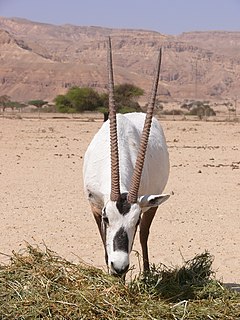Related Research Articles

The Arabian Desert is a vast desert wilderness in Western Asia. It stretches from Yemen to the Persian Gulf and Oman to Jordan and Iraq. It occupies most of the Arabian Peninsula, with an area of 2,330,000 square kilometers (900,000 sq mi). It is the fifth largest desert in the world, and the largest in Asia. At its center is Ar-Rub'al-Khali, one of the largest continuous bodies of sand in the world.

The Asiatic cheetah is a Critically Endangered cheetah subspecies surviving today only in Iran. It once occurred from the Arabian Peninsula and the Near East to the Caspian region, Transcaucasus, Kyzylkum Desert and India, but was extirpated in these regions during the 20th century.

The Eastern Mediterranean conifer-sclerophyllous-broadleaf forests, also known as the Eastern Mediterranean conifer-broadleaf forests, is an ecoregion in the eastern Mediterranean Basin. It covers portions of Turkey, Syria, Lebanon, Israel, Palestinian territories, Jordan, and Saudi Arabia.

The Yotvata Hai-Bar Nature Reserve is a 3,000-acre (12 km2) breeding and reacclimation center administered by the Israel Nature Reserves & National Parks Authority, situated in the Southern Arava near Yotvata.
The wildlife of Iran include the fauna and flora of Iran.
Wildlife of Azerbaijan consists of its flora and fauna and their natural habitats.

The Tibesti-Jebel Uweinat montane xeric woodlands is a deserts and xeric shrublands ecoregion in the eastern Sahara. The woodlands ecoregion occupies two separate highland regions, covering portions of northern Chad, southwestern Egypt, southern Libya, and northwestern Sudan.

The Elburz Range forest steppe ecoregion is an arid, mountainous 1,000-kilometer arc south of the Caspian Sea, stretching across northern Iran from the Azerbaijan border to near the Turkmenistan border. It covers 63,300 square kilometres (24,400 sq mi) and encompasses the southern and eastern slopes of the Alborz Mountains as well as their summits. The Caspian Hyrcanian mixed forests ecoregion, with its lush green mountainsides and plains that receive moisture from the Caspian Sea, forms this ecoregion's northern border. The vast Central Persian desert basins ecoregion forms its southern border.

The Badhyz State Nature Reserve is a protected area (zapovednik) in south-western Turkmenistan that was established in 1941 and extends over 877 km2 (339 sq mi) in the Mary and Akhal Provinces. It is located south of the Karakum Desert, and the Tejen River forms its western border.

Narayan Sarovar Sanctuary also popularly known as Narayan Sarovar Wildlife Sanctuary or Narayan Sarovar Chinkara Sanctuary notified as such in April 1981 and subsequently denotified in 1995 with reduced area, is a unique eco-system near Narayan Sarovar in the Lakhpat taluka of Kutch district in the state of Gujarat, India. The desert forest in this sanctuary is said to be the only one of its kind in India. Located in the arid zone, a part of it is a seasonal wetland. It has 15 threatened wildlife species and has desert vegetation comprising thorn and scrub forests. Its biodiversity has some rare animals and birds, and rare flowering plants. Wildlife Institute of India (WII) has identified it as one of the last remaining habitats of the cheetah in India and a possible reintroduction site for the species. The most sighted animal here is the chinkara, which is currently the flagship species of the sanctuary.

Khar Turan National Park or Touran Wildlife Refuge is a National Park in Iran. It is situated in the Semnan province, southeast of Shahrud. With a size of 1,400,000 hectares (14,000 km2), it is the second largest reserve in Iran. Khar Turan National Park also called the little Africa in Iran, is registered as the second biosphere reserve in the world by UNESCO, Turan National Park and Wildlife Refuge is one of the astonishing expanses to observe the mysteries of the wildlife accustomed to arid and semi-arid regions of Iran. Being the second-largest reserve in this country, this park embraces arid highlands, lowlands, mounts, sands, and endless salt pans.
Nayband Wildlife Sanctuary, Naybandan Wildlife Refuge or Nayband National Park is a National Park in Iran. It is situated in South Khorasan Province at 180.0 km (111.8 mi) south of Tabas, near the provincial city of Birjand, and Neyshabur and Mashhad from the Razavi Khorasan Province. With a size of 1,500,000 hectares (15,000 km2), it is the largest reserve in Iran. It has recently been given legal protection, and was known to have held the highest population of Asiatic cheetahs. Since 2006, it was estimated that at least 15 cheetahs live there.

The Mesopotamian shrub desert is a deserts and xeric shrublands ecoregion in Western Asia. It extends across portions of Israel, Jordan, Syria, Iraq, and Iran.
References
- 1 2 3 Mohammad S. Farhadinia, Bahman Shams Esfandabad, Mahmoud Karami, Fatemeh Hosseini-Zavarei, Hossein Absalan and Bagher Nezami: Goitered Gazelle Gazella subgutturosa Guldenstaedt, 1780: its habitat preference and conservation needs in Miandasht Wildlife Refuge, northeastern Iran. Zoology in the Middle East 46, 2009. PDF
- ↑ Female Asiatic Cheetah, cub sighted in Miandasht
- ↑ "Asiatic Cheetah spotted in NE Iran". 28 June 2015. Retrieved 3 July 2015.